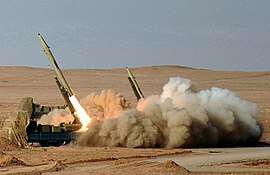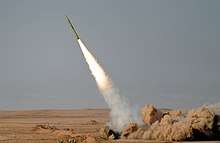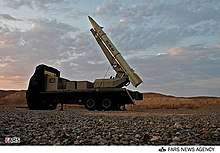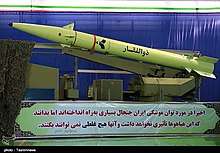Fateh-110
The Fateh-110 (Persian: فاتح-۱۱۰, "conqueror"), also known as NP-110 and Mushak[2], is an Iranian road-mobile single-stage solid-fueled surface-to-surface missile produced by Iran's Aerospace Industries Organization. The first generation of the Fateh-110 was flight tested in September 2002 and began mass production shortly thereafter. The initial range of the missile was 200 km and in September 2004 the second generation of the Fateh-110 increased the range to 250 km. The third generation of the missile, unveiled in 2010, increased the range to 300 km, and the fourth generation (2012) improved the accuracy.[3]
| Fateh 110 | |
|---|---|
 Fateh-110s in Iran's in "Great Prophet-7" military exercise, 2012 | |
| Type | Tactical SRBM |
| Service history | |
| In service | 2002–present |
| Used by | Iran Syria Hezbollah |
| Wars | Syrian Civil War |
| Production history | |
| Manufacturer | Iran |
| Unit cost | Unknown |
| Specifications | |
| Mass | 3,500 kg |
| Length | 8.90 m |
| Diameter | 0.60 m |
| Engine | single stage, solid fuel rocket |
Operational range | 300 km |
| Maximum speed | Mach 3.5 |
Guidance system | Inertial, global navigation satellite system[1] & electro-optical terminal |
| Accuracy | 3 m |
The Fateh-110 was developed from Iran's Zelzal-2 unguided artillery rocket essentially through adding a guidance system. Later versions of the missile modify other aspects of the missile and improve range and payload. The Fateh-110 is also license-built in Syria as the M-600. The missile has been used in the Syrian Civil War by Iran and Syria. In addition to its confirmed use by these two countries, it is widely reported that the Fateh-110 has been exported to Hezbollah in Lebanon.
Development
After the Iran–Iraq War, Iran found out that it needed an accurate short-range missile, as its Zelzal and Naze'at rockets were unguided rockets and thus very inaccurate. Thus, 200 Chinese CSS-8 short-range missiles were bought in 1989.[4] But those missiles did not satisfy Iranians because of their short range, relatively light warhead and bulky structure. So a project was assigned to Shahid Bagheri Industries to design and produce a guided short-range missile.
Development began in 1995 and Zelzal 2 was chosen for the basis of the missile. Reportedly Syria also joined the program and produced its version called M-600.[5] In 2006 the US Department of the Treasury accused Great Wall Industry, a Chinese corporation and its partners for playing a lead role in the development of the Fateh missile system, as Iran had no previous experience with solid fuelled ballistic missiles.[6][7] The first tests, which occurred in 2002, were successful, and the missile was put into production.
Variants
First generation

In 2002 the first generation of Fateh-110 began test flighting and entered service in 2002, it had a range of 200 km[8].
Second generation
In 2004, the second generation Fateh-110 was unveiled, with the range improved to 250 km. This version appears to be offered for export.[9]
M-600
It seems, as of 2008, that the Syrian M-600 is based on the second generation Fateh-110.[10] In 2010 the Israeli press claimed that Syria has given hundreds of M-600 missiles to Hezbollah.[11]
Third generation
In 2010, the third generation Fateh-110 was tested by Iran. Iranian defense minister Ahmad Vahidi stated that accuracy, range, reaction time and storage capability in different parts of the country are increased. After that Iranian TV provided footage of the test and the impact.[12] Some time later, it was delivered to IRGC.[13] The range of the missile was stated as 300 km.[14]
Anti-ship ballistic missile variants
In 2011, Iran unveiled the Khalij Fars anti-ship ballistic missile. It is clearly based on the Fateh-110 and shares the range of 300 km with the third version.
In 2017 Iran showed a test-fire of the Hormoz-2 missile, saying it destroyed a 6 m target from 250 km away. Iranian news described the Hormoz-2 as an anti-ship ballistic missile and an anti-radiation missile.[15][16]
Fourth generation

On August 2012 Iran successfully test-fired the fourth generation Fateh-110.[3]

Zolfaghar
The Zolfaghar is an Iranian tactical ballistic missile believed to be based in the Fateh-110 family and the first ballistic missile of any sort openly used by Iran in a foreign conflict.[17] Unlike the other members of the Fateh-110 family, which are often described as quasi-ballistic missiles, the Zolfaghar flies a true ballistic trajectory. The missile's claimed range of 700 km is considered largely true based on the 2017 Deir ez-Zor missile strike; this apparently results from replacing the metal body of the Fateh-110 with composite, saving substantial weight. However, doubts have been raised about its reliability and accuracy, and Jane's assesses that the Zolfaghar's performance is poor.[17]
The Zolfaghar (and possibly other members of the Fateh-110 family) are believed to use commercial GNSS systems to improve accuracy.[1] Zolfaghar serial numbers may begin "ZB–".[18]
Fateh Mobin
In 2018, Iran unveiled the Fateh Mobin guidance kit, an upgrade for Fateh-110 missiles. According to Iranian Defence Minister Amir Hatami, it can be retrofitted to members of the Fateh-110 family up to the Zolfaghar.[19] The Fateh Mobin is believed to be an infrared imaging sensor for terminal guidance.[19]
Operational history
Iran
As of 2017, Iran is assessed as having less than 100 launchers for all Fateh-110 variants.[20] It is believed that during the January 8, 2020 missile attack of the US military bases in Iraq, Iran used the Fateh-110 missile. [21]
Syria
On 3 and 5 May 2013, Israel said it had hit a shipment of Fateh-110 in Syria that were "destined for Hezbollah". Israel said it would not tolerate "game changing weapons" falling into the hands of Hezbollah.[22][23] On 18 May Israeli media claimed that the Syrian army had aimed a battery of Tishreen missiles, Syria's version of Iran's Fateh-110, at Tel Aviv according to reconnaissance satellites. These missiles are believed to see possible use as a deterrent against further Israeli airstrikes on Syrian targets.[24]
According to two unnamed U.S. military officials, the Syrian Government fired at least two Fateh A-110 missiles in late December 2012. The firing of these missiles appeared to be an effort to more precisely target Syrian rebels.[25]
In late November 2014, Iranian and Lebanese sources confirmed that Hezbollah had received Iranian Fateh-110 guided ballistic missiles and inducted them into their missile arsenal. With a 250–350 km (160–220 mi) range, Fateh-110 missiles fired from Lebanon could hit targets anywhere in Israel up to the northern Negev. Israel has regarded deliveries of such missiles as justification for preemptive response, as the previous year it attacked missile shipments, transport convoys, and storage sites in Syria and Lebanon to prevent these and other missile types from being acquired by Hezbollah.[26]
Design
The missile body is very similar to that of the Zelzal 2. It has the same diameter of 610 mm and a length of 8.86 m.
The Fateh-110 has three sets of fins. Four at the end of it near the exhaust, four other triangular shaped fins just above them and four small ones in front of missile near the nosecone. Of the three sets of fins on the missile, only the front ones are movable.
Transport

The Fateh-110 uses three different transporter-erector-launchers (TELs). The first one has a similar mechanism with SA-2 and is based on a Mercedes-Benz 6x6 truck. The second TEL is also used by newer versions of Zelzal rockets and again uses the Mercedes-Benz platform. The third one is an indigenous TEL called Zolfaghar that is able to carry two missiles instead of one.
Table
| Variant | Range | Warhead weight | Speed | Notes |
|---|---|---|---|---|
| Fateh-110 first generation | 200 km | 650 kg | Mach 3.5 | First variant. |
| Fateh-110 second generation | 250 km | 450 kg | Mach 3.7 | Announced in 2004. Also known as Fateh A-110 and Fateh-110A[27] |
| Fateh-110 third generation | 300 km | 650 kg | Mach 3 | Announced in 2010. Reports say that accuracy is also increased.[28] This variant is not named and is referred to by a variety of shorthand notations, such as "Fateh-110 block 3"[27] or "Fateh-110 Mod 3."[29] |
| Fateh-110 fourth generation | 300 km | 650 kg | Mach 3 | Addition of a new guidance system with "100% precision". Shown in 2012.[30] Also known as "Fateh-110-D1" |
| Khalij Fars | 300 km | 650 kg | Mach 3 | Anti-ship ballistic missile based on Fateh-110. Unveiled in 2011.[31] |
| Hormoz-1 | 300 km | 450–600 kg | Mach 4–5 | Anti-ship / anti-radar (ARM) ballistic missile.[16] |
| Hormoz-2 | 300 km | 450–600 kg | Mach 4–5 | Anti-ship / anti-radar (ARM) ballistic missile in May- 2014.[16][15] |
| M-600 or Tishreen | 250 km | 450 kg | Mach 3.7 | Syrian variant |
| Fateh-313 | 500 km | - | - | Successor to Fateh-110 versions.[32] |
| Zolfaghar | 750 km | - | - | newest version with submunitions warhead unveiled in 2016.[33][34] |
Operators
Non-state operators

See also
References
- Jeremy Binnie (2 July 2017). "Iran says it hit targets in Syria with Zolfaghar ballistic missiles". London: IHS Jane's Defence Weekly. Archived from the original on 2 July 2017.
- "Fateh-110/NP-110/Mushak". GlobalSecurity. Archived from the original on 1 January 2019.
- "DM Stresses High Precision Targeting Capability of Newly Unveiled Fateh-110 Missiles". 21 October 2012. Archived from the original on 13 September 2012. Retrieved 21 October 2012.
- "Tondar 69 (CSS-8) (Iran)". IHS Jane's. Archived from the original on 12 July 2011. Retrieved 9 August 2012.
- "Fateh A-110". MissileThreat.csis.org. Archived from the original on 4 November 2016. Retrieved 9 August 2012.
- Anthony H. Cordesman, with the assistance of Scott Modell, Aaron Lin, and Michael Peacock (7 October 2014). "Iran's Rocket and Missile Forces and Strategic Options" (PDF). Center for Strategic and International Studies. Archived (PDF) from the original on 18 October 2017. Retrieved 25 October 2017.CS1 maint: multiple names: authors list (link)
- Chris Smith and Matthew Wallin (August 2013). "Iranian Ballistic Missiles" (PDF). Archived (PDF) from the original on 25 October 2017. Retrieved 25 October 2017.
- "Iran's US-base-attacking missiles derive from China's HQ-2 missile". China Arms. Archived from the original on 20 February 2020.
- "MXF05-000350 Fateh-110 Surface to Surface Missile". Modlex. Archived from the original on 17 September 2012. Retrieved 9 August 2012.
- "Fateh A-110". CSIS Missile Threat. Archived from the original on 4 November 2016. Retrieved 13 November 2014.
- Yaakov Katz, Rebecca Anna Stoil (6 May 2010). "Hizbullah received hundreds of Syrian missiles". The Jerusalem Post. Archived from the original on 25 May 2013. Retrieved 9 August 2012.
- "آزمایش موفق نسل سوم موشك فاتح 110" (in Persian). Archived from the original on 28 August 2010.
- http://www.mehrnews.com/fa/NewsDetail.aspx?NewsID=1155522%5B%5D
- "سردار حاجيزاده اعلام كرد: برد نسل سوم موشك فاتح 110 به 300 كيلومتر رسيده است". Fars News. Archived from the original on 13 November 2014. Retrieved 13 November 2014.
- "PressTV-Iran successfully test-fires Hormuz-2 ballistic missile". Archived from the original on 26 September 2017. Retrieved 26 September 2017.
- "Fateh 110 missiles in Iran, Syria and Lebanon | Defense Update:". defense-update.com. Archived from the original on 11 October 2017. Retrieved 26 September 2017.
- "Proving grounds: Assessing Iranian weapon performance in Syria and Yemen" (PDF). Jane’s Defence Weekly (IHS Markit). 2018. Archived (PDF) from the original on 15 August 2018.
- Amir (24 October 2018). "Wreckage of what seems to be a missile has been found near the village of Fakhrabad in Iran's Khorasan Razavi province, 400 km from the Semnan missile test range".
- "Fateh Mobin Elevates Iranian Precision Ballistic Missile Capabilities". 13 August 2018. Archived from the original on 21 December 2018. Retrieved 21 December 2018.
- National Air and Space Intelligence Center (NASIC) in collaboration with the Defense Intelligence Ballistic Missile Analysis Committee (DIBMAC) (2017). "P2017 Ballistic and Cruise Missile Threat Report" (PDF). Defense Intelligence Ballistic Missile Analysis Committee. Archived (PDF) from the original on 27 January 2018. Retrieved 15 August 2018.
- Article in Army Technology
- "Israel confirms airstrike inside Syria". Al Jazeera. 4 May 2013. Archived from the original on 6 May 2013. Retrieved 6 May 2013.
- "Syria warns Israel after 'latest air raids'". Al Jazeera. 6 May 2013. Archived from the original on 6 May 2013. Retrieved 6 May 2013.
- Report: Assad preparing missile strike against Tel Aviv in case attacked again Archived 20 May 2013 at the Wayback Machine Haaretz, May 19, 2013
- Barbara Starr (28 December 2012). "U.S. officials: Syria using more accurate, Iranian-made missiles". CNN. Archived from the original on 6 February 2013. Retrieved 8 February 2013.
- Iran: We supplied ballistic guided rockets to Hezbollah Archived 27 November 2014 at the Wayback Machine – Defense-Update.com, 24 November 2014
- Galen Wright (15 March 2011) Iranian Military Capability 2011 - Ground Forces
- "Iran Test-Fires 3rd Generation of Fateh-110 Missile". Fars News. Archived from the original on 7 October 2011. Retrieved 15 April 2011.
- Tomlinson, Lucas (6 March 2017). "Iran launched 2 ballistic missiles, US officials say". Fox News. Archived from the original on 26 September 2017. Retrieved 26 September 2017.
- "Iran Test-Fires 4th Generation of Most Precise Home-Made Missile". Fars News. Archived from the original on 13 August 2012. Retrieved 4 August 2012.
- "Commander: IRGC Mass-Producing Anti-Ship Ballistic Missiles". Fars News. Archived from the original on 29 April 2011. Retrieved 15 April 2011.
- Iran Doubles ‘Fateh’ Guided Missile’s Range to 500km Archived 23 September 2015 at the Wayback Machine - Defense-Update.com, 22 August 2015
- "خبرگزاری فارس - شکست دیوار صوتی رسانهها با Su-22/ موشک نقطهزن ایران 750 کیلومتری شد". خبرگزاری فارس (in Persian). Fars News. 21 September 2016. Archived from the original on 24 September 2018. Retrieved 21 July 2019.
- Jeremy Binnie (28 September 2016). "Iran claims Zolfaghar missile has 700 km range". London: IHS Jane's Defence Weekly. Archived from the original on 29 September 2016.